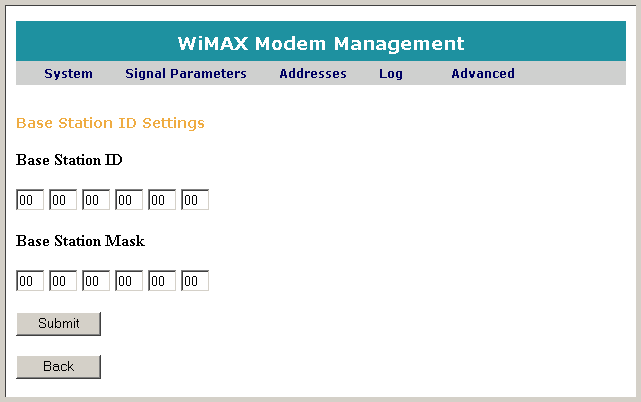
For the EasyST/ProST to communicate with a base station, the specific BS TRx must be defined at the EasyST/ProST. The base station is defined by a BS TRx ID (BSID) value and a BS TRx Mask value. The BS TRx ID value is the ID of the base station to which the EasyST/ProST is registered (authorized to communicate with). Multiple BS TRx can be defined for communication with the unit. This is typically relevant in roaming scenarios.
This functionality ensures that the EasyST/ProST establishes a communication link with authorized BS TRx(s).
The BS TRx ID is a 48-bit long programmable (user-defined) field identifying the BS TRx. The most significant 24 bits are used as the operator ID. This is a network management hook that can be used to restrict the EasyST/ProST from performing network entry with a predefined base station or a group of base stations.
The BS TRx Mask is a 48-bit programmable (user-defined) field that identifies which bits of the BS TRx ID require a match to enable the EasyST/ProST to associate with the BS TRx.
Example
for defining a single base station with which the unit can communicate:
Assume that the operator wishes to limit the network entry of an EasyST/ProST
to a specific BS TRx with
ID =0xAB5050123456. To enable this, the following configuration must be
performed:
Base Station ID: 'AB 50 50 12 34 56'
Base Station Mask: 'FF FF FF FF FF FF' (this is limited to one (1) specific BS TRx)
Example
for defining multiple base stations with which the unit can communicate:
The operator needs to set up a BSID plan in which it can identify,
for example, three BS TRxs
together. For example, it can divide the coverage area into zones of four
BS TRx. The zone number
shall be 22 bits and the BS index within the zone shall be 2 bits. If
the operator wishes to limit the unit access to zone #30, then the configured
parameters must be:
BS TRx ID: 'AB 50 50 00 00 78'
BS TRx Mask: 'FF FF FF FF FF FC'
Example
for defining an SS to work with a single Operator BS radios:
The operator may want to define the units (EasyST/ProST to work only
with BS radios that belong to the specific operator, but would not liks
to define to which specific BS radio to connect to.
To enable this the following must be performed:
To verify that the BS TRx radios have BS TRx IDs with the correct operator ID
To utilize the Web-based management (for EasyST/ProST) in order to define:
The BS TRx ID
Mask of : FF FF FF 00 00 00
Explanation:
As defined by iEEE802.16, the BS TRx Id is a 48-bit long programmable (user-defined0 field identifying the BS TRx. The most significant 24 bits are used as the operator ID:
F (hex) = 111 (binary)
0 (hex) = 0000 (binary)
To define the base station:
Access the Advanced page (see Accessing the Advanced Page).
In the Advanced page, select Base Station ID Settings and click Select. The Base Station ID Settings page appears, as shown below.

In the Base Station ID field, enter the identification number of the base station to which the unit must communicate.
In the Base Station Mask field, enter the mask to identify which bits of the Base Station ID require a match to enable the EasyST/ProST to associate with the BS TRx.
Click Submit. A page is displayed informing you that the new values have been saved, as shown below.
Alternatively click Back to return to the Advanced page without defining Base Station settings.

To apply the settings to the unit, you need to restart the unit. Perform the following:
Click Back to return to the Base Station ID Settings page.
Click Back to return to the Advanced page, and then follow the restart instructions in Restarting the Unit.
 Note: In the event the product type
is an EasyST with a SIM card, the SIM content will override the configured
values.
Note: In the event the product type
is an EasyST with a SIM card, the SIM content will override the configured
values.